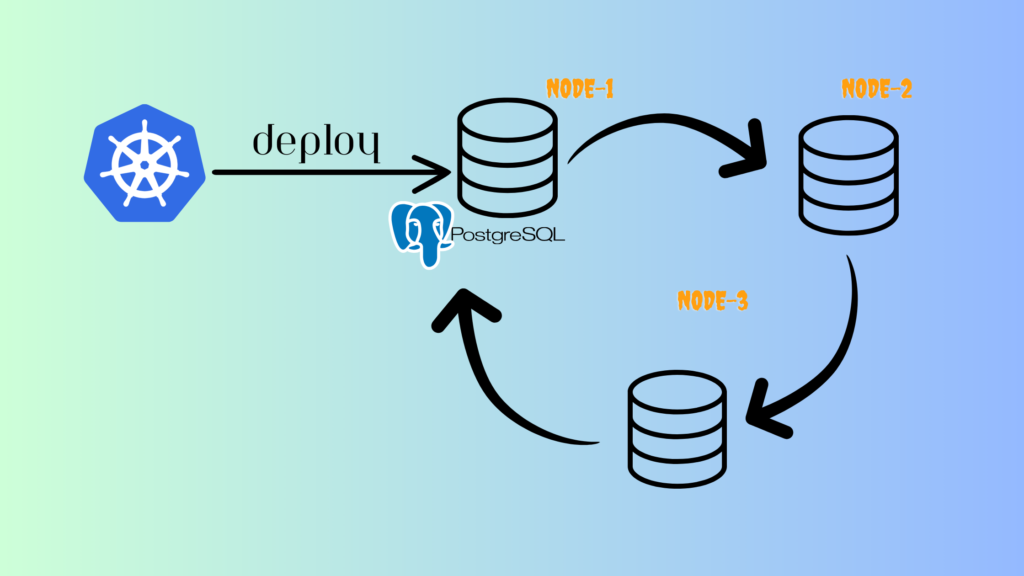Deploying PostgreSQL in a Kubernetes Cluster
Introduction
Kubernetes has become the go-to platform for deploying, managing, and scaling containerized applications. If you’re considering running a database in Kubernetes, PostgreSQL is a popular choice due to its reliability and robust features. In this article, we’ll explore how to deploy PostgreSQL in a Kubernetes cluster, ensuring high availability and scalability.

Prerequisites
- Kubernetes cluster up and running
- Kubectl command-line tool installed
- Basic knowledge of PostgreSQL
Deploying PostgreSQL
Deploying PostgreSQL in Kubernetes involves several steps:
- Storage Provisioning: Define a Persistent Volume (PV) and a Persistent Volume Claim (PVC) for PostgreSQL data storage.
- Secrets Management: Store PostgreSQL credentials securely as Kubernetes secrets.
- Deployment: Create a PostgreSQL deployment with defined resources, environment variables, and PVCs.
- Service: Expose PostgreSQL as a Kubernetes service for internal and external access.
Storage Provisioning YAML Example:
# postgres-pvc.yaml
apiVersion: v1
kind: PersistentVolumeClaim
metadata:
name: postgres-pvc
spec:
accessModes:
- ReadWriteOnce
resources:
requests:
storage: 10Gi
Secrets Management with Kubectl Command:
kubectl create secret generic postgres-credentials --from-literal=POSTGRES_USER=myuser --from-literal=POSTGRES_PASSWORD=mypassword
PostgreSQL Deployment YAML Example:
# postgres-deployment.yaml
apiVersion: apps/v1
kind: Deployment
metadata:
name: postgres-deployment
spec:
replicas: 1
template:
metadata:
labels:
app: postgres
spec:
containers:
- name: postgres
image: postgres:latest
env:
- name: POSTGRES_DB
value: mydb
- name: POSTGRES_USER
valueFrom:
secretKeyRef:
name: postgres-credentials
key: POSTGRES_USER
- name: POSTGRES_PASSWORD
valueFrom:
secretKeyRef:
name: postgres-credentials
key: POSTGRES_PASSWORD
ports:
- containerPort: 5432
volumeMounts:
- mountPath: /var/lib/postgresql/data
name: postgres-data
volumes:
- name: postgres-data
persistentVolumeClaim:
claimName: postgres-pvc
High Availability with StatefulSets
For high availability, consider using Kubernetes StatefulSets to manage your PostgreSQL instances. StatefulSets ensure that each PostgreSQL pod has a stable network identity and stable storage. This is crucial for maintaining data consistency and resilience.
StatefulSet YAML Example:
# postgres-statefulset.yaml
apiVersion: apps/v1
kind: StatefulSet
metadata:
name: postgres-statefulset
spec:
serviceName: postgres-service
replicas: 3
template:
metadata:
labels:
app: postgres
spec:
containers:
- name: postgres
image: postgres:latest
env:
- name: POSTGRES_DB
value: mydb
- name: POSTGRES_USER
valueFrom:
secretKeyRef:
name: postgres-credentials
key: POSTGRES_USER
- name: POSTGRES_PASSWORD
valueFrom:
secretKeyRef:
name: postgres-credentials
key: POSTGRES_PASSWORD
ports:
- containerPort: 5432
volumeMounts:
- mountPath: /var/lib/postgresql/data
name: postgres-data
volumes:
- name: postgres-data
persistentVolumeClaim:
claimName: postgres-pv
Scaling PostgreSQL
Kubernetes makes it easy to scale PostgreSQL horizontally by adding more replicas. You can also vertically scale by adjusting CPU and memory resources.
Backups and Disaster Recovery
Monitoring and Logging
Utilize Kubernetes-native monitoring and logging solutions like Prometheus, Grafana, and Elasticsearch to keep an eye on the health and performance of your PostgreSQL deployment.
Conclusion
Deploying PostgreSQL in a Kubernetes cluster offers flexibility, scalability, and high availability for your database workloads. By following best practices, you can ensure that your PostgreSQL deployment in Kubernetes is reliable and performs optimally, even in production environments.